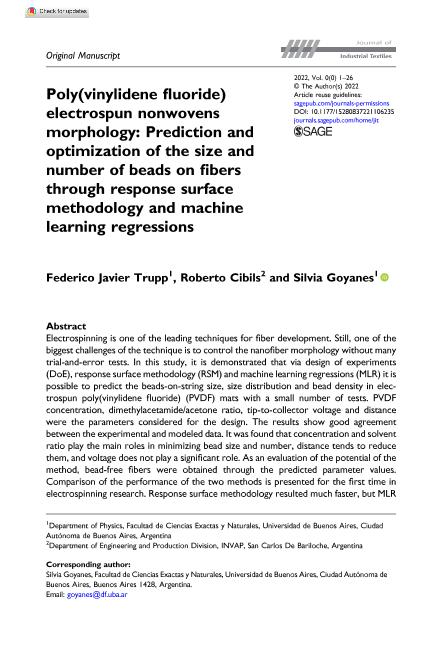Mostrar el registro sencillo del ítem
dc.contributor.author
Trupp, Federico Javier

dc.contributor.author
Cibils, Roberto Manuel

dc.contributor.author
Goyanes, Silvia Nair

dc.date.available
2023-09-29T11:10:21Z
dc.date.issued
2022-06
dc.identifier.citation
Trupp, Federico Javier; Cibils, Roberto Manuel; Goyanes, Silvia Nair; Poly(vinylidene fluoride) electrospun nonwovens morphology: Prediction and optimization of the size and number of beads on fibers through response surface methodology and machine learning regressions; SAGE Publications; Journal Of Industrial Textiles; 51; 5_suppl; 6-2022; 9071S-9096S
dc.identifier.issn
1528-0837
dc.identifier.uri
http://hdl.handle.net/11336/213539
dc.description.abstract
Electrospinning is one of the leading techniques for fiber development. Still, one of the biggest challenges of the technique is to control the nanofiber morphology without many trial-and-error tests. In this study, it is demonstrated that via design of experiments (DoE), response surface methodology (RSM) and machine learning regressions (MLR) it is possible to predict the beads-on-string size, size distribution and bead density in electrospun poly(vinylidene fluoride) (PVDF) mats with a small number of tests. PVDF concentration, dimethylacetamide/acetone ratio, tip-to-collector voltage and distance were the parameters considered for the design. The results show good agreement between the experimental and modeled data. It was found that concentration and solvent ratio play the main roles in minimizing bead size and number, distance tends to reduce them, and voltage does not play a significant role. As an evaluation of the potential of the method, bead-free fibers were obtained through the predicted parameter values. Comparison of the performance of the two methods is presented for the first time in electrospinning research. Response surface methodology resulted much faster, but MLR achieved a lower error and better generalization abilities. This approach and the availability of the MLR script used in this work may help other groups implement it in their research and find information hidden in the data while improving model prediction performance.
dc.format
application/pdf
dc.language.iso
eng
dc.publisher
SAGE Publications

dc.rights
info:eu-repo/semantics/openAccess
dc.rights.uri
https://creativecommons.org/licenses/by-nc-sa/2.5/ar/
dc.subject
BEAD FORMATION
dc.subject
ELECTROSPINNING
dc.subject
MACHINE LEARNING REGRESSIONS
dc.subject
POLY(VINYLIDENE FLUORIDE)
dc.subject
PREDICTION AND OPTIMIZATION
dc.subject
RESPONSE SURFACE METHODOLOGY
dc.subject.classification
Otras Ciencias Físicas

dc.subject.classification
Ciencias Físicas

dc.subject.classification
CIENCIAS NATURALES Y EXACTAS

dc.title
Poly(vinylidene fluoride) electrospun nonwovens morphology: Prediction and optimization of the size and number of beads on fibers through response surface methodology and machine learning regressions
dc.type
info:eu-repo/semantics/article
dc.type
info:ar-repo/semantics/artículo
dc.type
info:eu-repo/semantics/publishedVersion
dc.date.updated
2023-07-07T22:26:20Z
dc.journal.volume
51
dc.journal.number
5_suppl
dc.journal.pagination
9071S-9096S
dc.journal.pais
Estados Unidos

dc.description.fil
Fil: Trupp, Federico Javier. Universidad de Buenos Aires. Facultad de Ciencias Exactas y Naturales. Departamento de Física. Laboratorio de Polímeros y Materiales Compuestos; Argentina. Consejo Nacional de Investigaciones Científicas y Técnicas. Oficina de Coordinación Administrativa Ciudad Universitaria. Instituto de Física de Buenos Aires. Universidad de Buenos Aires. Facultad de Ciencias Exactas y Naturales. Instituto de Física de Buenos Aires; Argentina
dc.description.fil
Fil: Cibils, Roberto Manuel. Invap S. E.; Argentina
dc.description.fil
Fil: Goyanes, Silvia Nair. Universidad de Buenos Aires. Facultad de Ciencias Exactas y Naturales. Departamento de Física. Laboratorio de Polímeros y Materiales Compuestos; Argentina. Consejo Nacional de Investigaciones Científicas y Técnicas. Oficina de Coordinación Administrativa Ciudad Universitaria. Instituto de Física de Buenos Aires. Universidad de Buenos Aires. Facultad de Ciencias Exactas y Naturales. Instituto de Física de Buenos Aires; Argentina
dc.journal.title
Journal Of Industrial Textiles

dc.relation.alternativeid
info:eu-repo/semantics/altIdentifier/url/https://journals.sagepub.com/doi/10.1177/15280837221106235
dc.relation.alternativeid
info:eu-repo/semantics/altIdentifier/doi/https://doi.org/10.1177/15280837221106235
Archivos asociados
